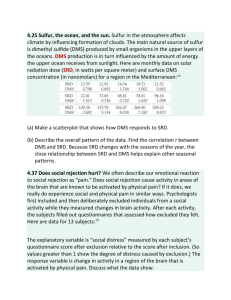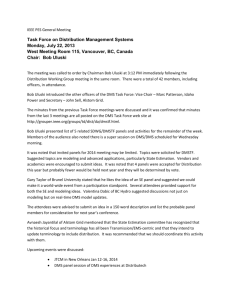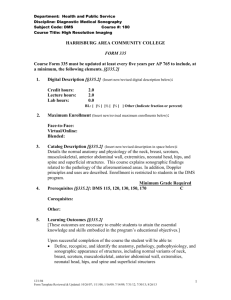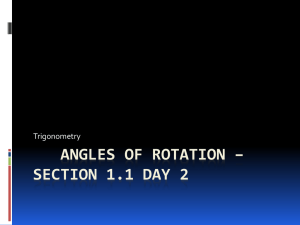Study of exchange bias between IrMn and ZnCoO Dilute Magnetic
advertisement
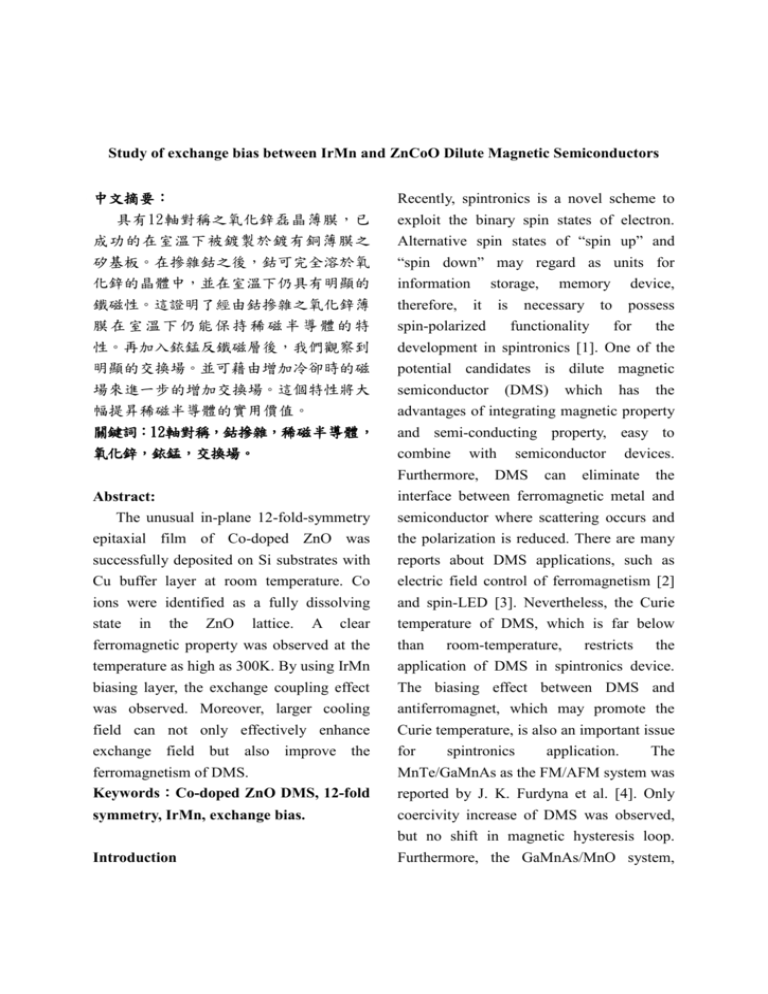
Study of exchange bias between IrMn and ZnCoO Dilute Magnetic Semiconductors
中文摘要:
具有12軸對稱之氧化鋅磊晶薄膜,已
成功的在室溫下被鍍製於鍍有銅薄膜之
矽基板。在摻雜鈷之後,鈷可完全溶於氧
化鋅的晶體中,並在室溫下仍具有明顯的
鐵磁性。這證明了經由鈷摻雜之氧化鋅薄
Recently, spintronics is a novel scheme to
exploit the binary spin states of electron.
Alternative spin states of “spin up” and
“spin down” may regard as units for
information storage, memory device,
therefore, it is necessary to possess
膜在室溫下仍能保持稀磁半導體的特
性。再加入銥錳反鐵磁層後,我們觀察到
明顯的交換場。並可藉由增加冷卻時的磁
spin-polarized
functionality
for
the
development in spintronics [1]. One of the
potential candidates is dilute magnetic
場來進一步的增加交換場。這個特性將大
幅提昇稀磁半導體的實用價值。
關鍵詞:12軸對稱,鈷摻雜,稀磁半導體,
氧化鋅,銥錳,交換場。
Abstract:
The unusual in-plane 12-fold-symmetry
semiconductor (DMS) which has the
advantages of integrating magnetic property
and semi-conducting property, easy to
combine with semiconductor devices.
Furthermore, DMS can eliminate the
interface between ferromagnetic metal and
semiconductor where scattering occurs and
epitaxial film of Co-doped ZnO was
successfully deposited on Si substrates with
Cu buffer layer at room temperature. Co
ions were identified as a fully dissolving
state in the ZnO lattice. A clear
ferromagnetic property was observed at the
temperature as high as 300K. By using IrMn
biasing layer, the exchange coupling effect
was observed. Moreover, larger cooling
field can not only effectively enhance
the polarization is reduced. There are many
reports about DMS applications, such as
electric field control of ferromagnetism [2]
and spin-LED [3]. Nevertheless, the Curie
temperature of DMS, which is far below
than room-temperature, restricts the
application of DMS in spintronics device.
The biasing effect between DMS and
antiferromagnet, which may promote the
Curie temperature, is also an important issue
exchange field but also improve the
ferromagnetism of DMS.
Keywords:Co-doped ZnO DMS, 12-fold
for
spintronics
application.
The
MnTe/GaMnAs as the FM/AFM system was
reported by J. K. Furdyna et al. [4]. Only
coercivity increase of DMS was observed,
but no shift in magnetic hysteresis loop.
Furthermore, the GaMnAs/MnO system,
symmetry, IrMn, exchange bias.
Introduction
temperature of ZnO-based DMS may be
higher than room temperature. Here, we
perform a room temperature manufacture to
fabricate ZnO-based DMS. Moreover, we
also choose IrMn as AFM to study the
exchange effect between DMS and AFM.
Experiment
Samples with the structure of Si/Cu(400
Å)/ZnCo0.07O(400 Å)/Cu(2 Å)/IrMn(100
by ICP-MS. In order to exclude the
existence of cobalt clusters in ZnO matrix,
the HRTEM and XPS analysis were used.
sample A
sample B
Intensity (a.u.)
Results and discussion
Intensity (a. u.)
reported by K. F. Eid [5], showed an
exchange bias, implying the annealing
process may result in the formation of
ferromagnetic MnAs. ZnO is a material of a
direct band gap semiconductor, which was
used for transparent thin film transistors, gas
sensor, optoelectronic devices [6-7].
According to the theoretical calculation and
actual measurements [8-9], the Curie
(a) ZnO {1011}
(b) Cu {111}
0
ZnCoO(0002)
120
35
180
240
300
360
(degree)
IrMn(111)
Si
30
60
Cu(200)
40
45
50
2 (degree)
55
60
Figure 1. The x-ray θ-2θ scans results of sample ‘A’ & ’B’. The
insert is the Φ-scans of ZnCoO and Cu.
The structure of sample A and sample B
were identified by XRD pattern, shown in
figure 1. A strong peak of ZnCoO (0002)
was observed in both samples, implying the
Cu underlayer can certainly induce the
Å)/Cu (sample ‘A’) and Si/Cu(400
Å)/ZnCo0.07O(400 Å) (sample ‘B’) were
fabricated at room temperature by Ion Beam
Deposition (IBD). All Si(100) substrates
were cleaned by HF. The 2 Å of Cu spacer,
in sample A, plays an important role to
avoid oxidation-reduction and also enhance
IrMn(111) texture. The ZnCoO was
prepared by Zn target (99.995%) with Co
growth of ZnCoO (0002). Moreover, the Cu
underlayer can also use as a bottom
electrode in device. The result of x-ray
Φ-scans, shown in insert, reveals an
chips (99.99%) and introducing mixed gas
of Ar (6 sccm) and O2 (3.2 sccm). The M-H
loop of ZnCoO was measured by SQUID.
The structure was identified by x-ray
Φ-scans and TEM dark-field images, and
along the Cu [110] direction. The selected
area diffraction (SAD) pattern of ZnCoO,
shown in figure 2 (a) and (b), reveals that
only two kind diffraction patterns of (110)
and (1-10) were observed. Moreover, the
dark field images taken from (110) and
the composition of ZnCoO was confirmed
unusual structure which has 12-fold
symmetry. The cross-section image of TEM
shows that ZnCoO is a columnar structure.
To analyze the structure of ZnCoO, the
direction of the electron beam was tilted to
(1-10), shown in figure 2 (c) and (d), are
complementary, indicating ZnCoO film is a
bi-crystalline epitaxial film. Therefore, films
of ZnCoO show a 12-fold symmetry.
a
b
(002)
(002)
The result, shown in figure 3, shows the
energy difference between 2P1/2 and 2P3/2 is
15.6 eV, implying the states of Co is
oxidized. (For Co clusters, it shall be 15.05
eV.)
(110)
Magnetization (emu/cc)
40
(110)
30
20
300K
Co=7%
HC=70Oe
10
0
-10
-20
-30
-40
c
d
-3
-2
-1
0
1
2
3
Magnetic field (KOe)
Figure 4. The SQUID result of sample ‘B’ @ 300 K.
Figure 2. Sample ‘B’ shows two kinds of SAD t patterns of (110)
(Fig. (a)) and (1-10) (Fig. (b)). Dark-field images of sample ‘B’
taking from (110) (Fig. 2(c)) and (1-10) (Fig. 2(d)) diffraction
patterns.
From the HR-TEM and SAD pattern of
ZnCoO, no second phase precipitation or
extra diffraction pattern was observed in the
whole area, implying no nano-size Co
clusters and other phase in the ZnCoO film.
To further study the status of Co in ZnO
matrix, the XPS was used to identify the
valence
states
of
Co.
The SQUID result measured at room
temperature, shown in Figure 4, reveals
sample B is ferromagnetism, indicating the
Curie temperature of ZnCoO is above 300 K.
To further discuss the exchange coupling
between ZnCoO and IrMn, the zero-field
cooling and field cooling (+3000 Oe)
hysteresis loops of sample ‘A’ and ‘B’ were
measured at 5 K. The results show in figure
5. In sample ‘A’, a clear exchange bias was
observed. However, no exchange bias effect
was observed in sample ‘B’. This result not
only implies the exchange bias effect results
from the exchange coupling between
ZnCoO and IrMn, but also excludes the
Intensity (a. u.)
781.86 eV
797.47 eV
810 805 800 795 790 785 780 775 770
Binding energy (eV)
Figure 3. The XPS result of ZnCoO in sample ‘B’
contribution of CoO/ZnCoO. Remarkably,
the Ms value of FC curve measured under 3
TOe is 5~6 times large than ZFC one.
Generally, the IrMn will not contribute to
the Ms value. The enhancement of Ms value
may result from the ZnCoO layer which
have some antiferromagnetic coupling
moment and isolated moment which are
reinforced by the cooling field. Hence, the
exchange field increases from 0 for ZFC and
55 Oe for 3 KOe to 80 Oe for 3 TOe.
(a)
Magnetization (emu/cc)
80
60
measured at 5K
40
20
ZFC
FC (+3KOe)
0
-20
Applied Physics 91, 7490 (2002)
[5] K. F. Eid, M. B. Stone, K. C. Ku, O.
Maksimov, P. Schiffer, N. Samartha, T.
-40
-60
-80
-3
-2
-1
0
1
2
3
Magnetic field (KOe)
(b)
Magnetization (emu/cc)
150
100
50
0
-50
ZFC
FC (3KOe)
FC (3TOe)
-100
-150
-3
-2
-1
0
1
2
3
Magnetic field (KOe)
Figure 5. The SQUID result of (a) sample ‘A’ (b) sample ‘B’@
300 K.
Conclusion
We observed the exchange coupling
between IrMn and ZnCoO DMS. Moreover,
larger cooling field can not only effectively
enhance exchange field but also improve the
ferromagnetism of DMS. The enhancement
of ferromagnetism by using cooling filed
and biasing effect between AFM and DMS
can promote the application of DMS in
spintronics.
Reference
[1] H. Ohno, Science 281, 951 (1998)
[2] H. Ohno, D. Chiba, F. Matsukura, T.
Omiya, E. Abe, T. Dietl, Y. Ohno, K.
Ohtani, Nature 408, 944 (2000)
[3] Y. Ohno, D. K. Young, B. Beschoten, F.
Matsukura, H. Ohno, D. D. Awschalom,
Nature 402, 790 (1999)
[4] J. K. Furdyna, X. Liu, Y. Sasaki and S. J.
Potashnik, P. Schiffer, Journal of
C. Shih and C. J. Palmstrøm, Applied
Physics Letters 85, 1556 (2004)
[6] Y. W. Heo, L. C. Tien, D. P. Norton, B.
S. Kang , F. Ren, B. P. Gila and S. J.
Pearton, Applied Physics Letters 85,
2002 (2004)
[7] A. K. Sharma, J. Narayan, J. F. Muth, C.
W. Teng, C. Jin, A. Kvit, R. M. Kolbas,
and O. W. Holland, Applied Physics
Letters 75, 3327 (1999)
[8] K.Sato, Jpn. J. Appl. Phys. 39, L555
(2000)
[9] M. Venkatesan, C. B. Fitzgerald, J.G.
Lunney, and J.M. D. Coey, Physical
Review Letters 93, 177206 (2004)
